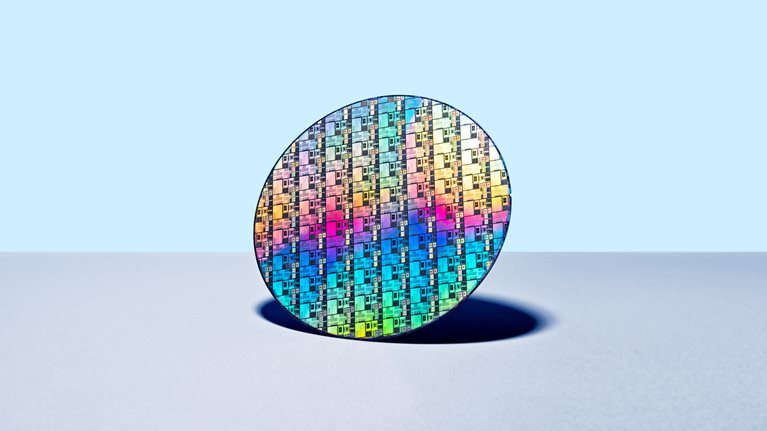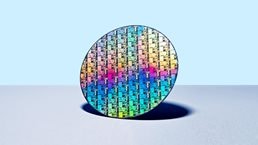
Colourful Iridescent Silicon Pc Wafer on Blue Coloured Background.
The expression “semiconductor scarcity” is a type of pandemic-era catchphrases—like “provide chain problems” or “bodily distancing” or “sourdough starter”—that may more than likely conjure reminiscences of deep lockdown and the uninteresting pain of a phantom masks at the back of your ears for future years. However many of us have a murky figuring out of what a semiconductor in reality is. It’s possible you’ll know that semiconductors have one thing to do with why your automobile used to be value much more than you idea it used to be. However many people can be onerous pressed to give an explanation for what they in reality are.
A primary step can be to wreck down the phrase. A conductor, as you could bear in mind from elementary-school science magnificence, is one thing during which electrons freely transfer from one form of subject matter to some other. Ever gotten a surprise within the iciness after touching a doorknob? That’s as a result of steel is a brilliant conductor of electrical energy. (In reality, so is the human frame, which is why you’ll be able to once in a while go the surprise directly to an unsuspecting sufferer.) The other of a conductor is an insulator, which impedes the glide of electrons from one subject matter to some other. Rubber is a brilliant insulator, which is why it’s secure to be inside of a automobile (with rubber tires) right through a lightning typhoon.
A semiconductor is a substance that falls someplace at the continuum between conductor and insulator. Producers procedure silicon and different fabrics into semiconductors for a wide variety of digital gadgets that depend on harnessing electrical energy for processing persistent. And those semiconductors, or chips, are in larger call for than ever earlier than: the Fourth Commercial Revolution (4IR), which is recently remodeling production, manufacturing, and world industry extra in most cases, is characterised by means of good computer systems and hooked up gadgets. Good manner hooked up, and hooked up manner chips.
Whilst semiconductors can open a wealth of alternative for industries around the globe, reliance on semiconductors has offered some vulnerabilities when provide falls in need of call for. On this McKinsey Explainer, we’ll discover the roots of the pandemic-era semiconductor scarcity, how organizations can mitigate the hazards related to reliance on semiconductors, and why semiconductors stand to dominate the following decade in world industry.
Be told extra about McKinsey’s Semiconductors Observe.
What brought about the semiconductor scarcity? And why has it been so destructive?
Contents
- 1 What brought about the semiconductor scarcity? And why has it been so destructive?
- 2 Is the semiconductor scarcity over now?
- 3 What’s the possibility of the semiconductor trade?
- 4 How can semiconductor corporations meet hovering call for?
- 5 How can the semiconductor trade stay its emissions in test because it grows?
A couple of yr into the COVID-19 pandemic, a scarcity of tiny silicon chips made giant waves in industries during the sector. Within the first quarter of 2021, manufacturing meeting traces for the entirety from smartphones to house home equipment to driver-assistance techniques floor to a halt. The car trade used to be specifically affected: main carmakers introduced vital rollbacks of their manufacturing, inflicting earnings disruptions to the song of billions of bucks. (This, in flip, brought about an building up within the price of many used vehicles.)
Listed below are one of the crucial elements that contributed to the semiconductor disaster:
-
An trade already at complete capability
Recognized for its cyclicality, semiconductor production has traditionally been a boom-and-bust trade. After greater than a decade of consolidation, trade behavior become extra rational, with capability additions intently matching call for enlargement since about 2016. When the pandemic hit, the trade’s production property have been running at with reference to 95 % usage.
-
Pandemic-related struggles
The seeds of the semiconductor disaster within the auto trade may also be traced to the early days of the pandemic, when auto gross sales plummeted globally—by means of up to 80 % in Europe. On the similar time, call for spiked for private computer systems, servers, and gear for stressed out conversation, pushed by means of the shift to faraway paintings. So whilst automakers’ orders for semiconductors (to be used in fuel-pressure sensors, virtual speedometers, navigation shows, and extra) dropped off sharply, personal-electronics producers have been ordering greater than ever. When the car sector’s call for recovered in the second one part of 2020, the semiconductor trade had already shifted to fulfill the call for of different varieties of producers.
-
The lengthy highway to construction new semiconductor production amenities
Semiconductor fabrication amenities, or “wafer fabs,” take years to construct and value billions of bucks. From the verdict so as to add a brand new fab, it takes even the most productive producers greater than 3 years to construct the semiconductor blank room, set up apparatus, and ramp up manufacturing to a top yield.
-
Geopolitical tensions
US sanctions on China brought about many Chinese language corporations to hoard chips, which resulted in political tensions and greater marketplace strain.
-
Contract phrases
Contracts for auto portions in most cases have shorter supply instances than contracts for portions in different industries. So when the car trade used to be able to put extra orders, the semiconductor producers have been tied up in longer contracts serving different industries.
-
5G rollout and overlapping chip call for
5G generation will depend on the similar form of semiconductor chips as vehicles. Because of this, automakers might enjoy persevered chip shortages as 5G continues to roll out globally.
Is the semiconductor scarcity over now?
In a phrase, no. In some spaces like general-purpose microprocessors and reminiscence chips, there’s vital extra stock. However there’s nonetheless a world scarcity of distinctiveness chips utilized in sure automobile and business programs. For the reason that semiconductor trade used to be already below pressure earlier than the pandemic, COVID-19 created a spike in call for that the trade remains to be improving from. In line with McKinsey research, the lack will most probably persist for particular varieties of chips a minimum of till summer season 2025, if no longer longer.
Be told extra about McKinsey’s Semiconductors Observe.
What’s the possibility of the semiconductor trade?
The arena of the long run runs on semiconductors. Tendencies similar to faraway operating, the proliferation of man-made intelligence, and hovering call for for electrical cars are reshaping the sector we are living in. Accordingly, the worldwide semiconductor trade is poised for a decade of enlargement. McKinsey initiatives trade revenues to climb to $1 trillion by means of 2030.
About 70 % of this enlargement will likely be spurred by means of simply 3 industries: automobile, computation and information garage, and wi-fi. In automobile on my own, McKinsey foresees a tripling in call for, partially on account of expanding call for for electrical cars. On that foundation, this phase can be chargeable for up to 20 % of trade growth over the approaching years.
How can semiconductor corporations meet hovering call for?
Having a look on the numbers, it kind of feels like an attractive excellent time to be within the semiconductor industry. Call for is hovering, and annual revenues greater 23 % in 2021—a long way above the 5 % building up reported in 2019. In 2021, shareholders in semiconductor corporations noticed a median of fifty % go back as semiconductors helped persistent the virtual revolution.
However having a look nearer, semiconductor corporations are going through vital demanding situations. The trade shortages that came about right through the pandemic driven governments to carry chip production nearer to house. Skill shortages, each in engineering-related roles and craft exertions, will want to be addressed. Chips will turn into dearer as they’re manufactured in much less economically advantaged places. Discovering the huge amounts of solid electrical persistent and natural water wanted for some semiconductor production processes additionally isn’t simple.
McKinsey has recognized a number of methods that can lend a hand semiconductor corporations beef up productiveness, in addition to perceive when capability growth may also be justified. Listed below are six essential spaces during which semiconductor corporations can assessment their strengths and weaknesses:
-
Generation management
The race for dominance within the semiconductor trade is on, and the winner will likely be whichever corporate can manufacture the smallest, quickest, and maximum power-efficient gadgets.
-
Lengthy-term R&D
Semiconductor corporations have confirmed that daring, long-term investments can ultimately ship considerable returns that receive advantages no longer simply shareholders but in addition society as a complete. The introduction of specialised chips for quantum computing, for instance, may beef up pharmaceutical construction and sustainability techniques.
-
Resilience
The massive disruptions coming up from the COVID-19 pandemic are nonetheless making critical waves in world industry. Something is apparent: resilience is wanted in all sectors to climate the uncertainties of the long run. Semiconductor corporations may paintings to turn into extra agile, which might permit them to reply extra briefly to adjustments available in the market.
-
Skill
Semiconductor production amenities are being advanced in new areas, which calls for new assets of ability. Along with expanding their efforts to recruit ability, corporations within the semiconductor trade too can deal with office beauty problems reported by means of workers.
-
Ecosystem features
Larger collaboration with different semiconductor corporations may end up helpful in addressing demanding situations associated with advanced chip design and pageant for ability. For instance, one corporate may increase highbrow belongings and license it to others.
-
Larger capability
In spite of everything, capability growth may ship advantages for some semiconductor corporations. However those aren’t simple selections to make: building for a brand new semiconductor fabrication plant takes as much as 3 years and will charge up to $5 billion. Corporations must intently read about the professionals and cons of accepting executive subsidies, partnering with apparatus producers, and different possible cost-saving measures earlier than continuing.
If semiconductor corporations can meet call for, they may sail via the following decade.
Be told extra about McKinsey’s Semiconductors Observe.
How can the semiconductor trade stay its emissions in test because it grows?
Powering the 4IR is a essential crucial. But it surely’s no longer the one one. Shoppers are an increasing number of difficult that their providers step up efforts to scale back greenhouse-gas emissions to succeed in a 1.5°C carbon pathway. Semiconductor corporations have made local weather commitments, however at the present those commitments don’t seem to be sufficient to restrict emissions as required by means of the 2016 Paris Settlement. Getting the trade to internet 0 would require extra complete, collaborative motion.
Listed below are some steps the trade may take within the brief time period:
- Fuel abatement techniques might be put in to develop into damaging gases into ones with much less global-warming possible.
- Warmth-transfer fluids might be changed with ones with decrease global-warming possible.
- Gasoline provides might be substituted with blank choices like hydrogen or biomass.
In the long term, semiconductor corporations will want to shift towards a extra leading edge manner, making larger funding in decarbonization and appearing a willingness to experiment with leading edge answers. Collaboration will likely be useful right here: corporations may increase early-stage decarbonization applied sciences with start-ups and educational labs, then percentage with a consortium of businesses.
Be told extra about McKinsey’s Semiconductors Observe—and try semiconductor-related activity alternatives in the event you’re focused on operating at McKinsey.
Articles referenced:
- “What’s quantum computing?,” Might 1, 2023
- “What’s AI?,” April 24, 2023
- “What’s agile?,” March 27, 2023
- “What’s an EV?,” February 6, 2023
- “What’s resilience?,” January 17, 2023
- “What are Trade 4.0, the Fourth Commercial Revolution, and 4IR?,” August 17, 2022
- “Holding the semiconductor trade at the trail to internet 0,” November 4, 2022, Sebastian Göke, Mena Issler, Demi Liu, Mark Patel, and Peter Spiller
- “Will the provision–call for mismatch persist for automobile semiconductors?,” October 14, 2022, Ondrej Burkacky, Johannes Deichmann, Michael Guggenheimer, and Philip Pfingstag
- “How semiconductor makers can flip a ability problem right into a aggressive merit,” September 7, 2022, Ondrej Burkacky, Ulrike Kingsbury, Andrea Pedroni, Giulietta Poltronieri, Matt Schrimper, and Brooke Weddle
- “Semiconductor scarcity: How the automobile trade can be successful,” June 10, 2022, Ondrej Burkacky, Johannes Deichmann, Philipp Pfingstag, and Julia Werra
- “Methods to guide within the semiconductor global,” April 15, 2022, Ondrej Burkacky, Marc de Jong, and Julia Dragon
- “The semiconductor decade: One trillion-dollar trade,” April 1, 2022, Ondrej Burkacky, Julia Dragon, and Nikolaus Lehmann
- “Worth introduction: How can the semiconductor trade stay outperforming?,” October 15, 2021, Ondrej Burkacky, Marc de Jong, Ankit Mittal, and Nakul Verma
- “Dealing with the auto-semiconductor scarcity: Methods for good fortune,” Might 27, 2021, Ondrej Burkacky, Stephanie Lingemann, and Klaus Pototzky

Supply By means of https://www.mckinsey.com/featured-insights/mckinsey-explainers/what-is-a-semiconductor

